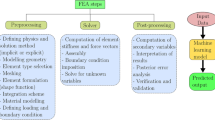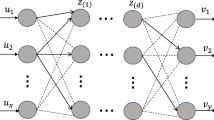Abstract
The prediction of the consequences of a ballistic impact is highly relevant in the advanced material engineering. Traditionally, the solution of this kind of problems was made by means of experimental tests, analytical models or numerical simulations. In this domain, the particularities of the phenomenon at high speed increase the difficulty of the mathematical resolution of the equations associated, and the complexity of the mechanical behaviour of the materials at high strain rates complicates the numerical simulation of the problem. Therefore, this paper describes a neural network--based methodology applied to recreate the ballistic impact phenomenon. The objective of this study is threefold. Firstly, to obtain the most precise prediction possible, minimizing the amount of data used. Secondly, to discover and analyse the influence of each of the variables on the entire neuronal model. Finally, to compare the precision and performance of this methodology with other alternatives of learning machine. The empirical results have shown that the proposed methodology is an interesting approach to reliably solving ballistic impact problems.








Similar content being viewed by others

References
ABAQUS: ABAQUS/Explicit v6.4 Users Manual. ABAQUS Inc., Richmond, USA. (2003)
Adeli H, Yeh C (1989) Perceptron learning in engineering design. Microcomput Civil Eng 4:247–256
Anderson C, Bodner S (1988) Ballistic impact: the status of analytical and numerical modeling. Int J Impact Eng 7(1):9–35
Anlauf J, Biehl M (1989) The adatron: an adaptive perceptron algorithm. Europhys Lett 10:687–692
Arias A, Rodríguez-Martínez JA, Rusinek A (2008) Numerical simulations of impact behaviour of thin steel plates subjected to cylindrical, conical and hemispherical non-deformable projectiles. Eng Fract Mech 75(6):1635–1656
Arias A, Zaera R, López-Puente J, Navarro C (2003) Numerical modeling of the impact behavior of new particulate-loaded composite materials. Compos Struct 61(1–2):151–159 Impact on Composites 2002
Awerbuch J, Bodner S (1974) Analysis of the mechanics of perforation of projectiles in metallic plates. Int J Solids Struct 10:671–684
Backman M, Goldsmith W (1978) The mechanics of penetration of projectiles into targets. Int J Eng Sci 16(1):1–99
Ben-Dor G, Dubinsky A, Elperi T (2005) Ballistic impact: recent advances in analytical modeling of plate penetration dynamics. A review. Appl Mech Rev 58(6):355–371
Bisagni C, Lanzi L, Ricci S (2002) Optimization of helicopter subfloor components under crashworthiness requirements using neural networks. J Aircr 39(2):296–304
Bishop C (1996) Neural networks for pattern recognition. Oxford University Press, New York
Borvik T, Langseth M, Hopperstad O, Malo K (1999) Ballistic penetration of steel plates–analysis and experiment. Int J Impact Eng 22(9–10):855–886
Broomhead D, Lowe D (1988) Multivariable functional interpolation and adaptive networks. Complex Syst 2:321–355
Cover M (1969) Learning in pattern recognition. Methodologies of Pattern Recognition pp 111–132
Cover T (1965) Geometrical and statistical properties of systems of linear inequalities with applications in pattern recognition. IEEE Trans Elect Comput EC-14(3):326–334
Cybenko G (1989) Approximation by superpositions of a sigmoidal function. Math Control Signals Syst 2:303–314
Devijver P, Kittler J (1982) Pattern recognition: a statistical approach. Prentice Hall, London
Dua R, Watkins S, Wunsch D, Chandrashekhara K, Akhavan F (2001) Detection and classification of impact-induced damage in composite plates using neural networks. In: International joint conference on neural networks (IJCNN 01), pp 681–686
Farrar C, Leeming D (1983) Military ballistics: a basic manual. Brassey’s Defence Publishers, New York
Fawaz Z, Heng W, Ehdinan K (2004) Numerical simulation of normal and oblique ballistic impact on ceramic composite armours. Compos Struct 63(3–4):387–395
Foley D (1972) Considerations of sample and feature size. IEEE Trans Infor Theory 18(5):618–626
Garcia-Crespo A, Ruiz-Mezcua B, Fernandez D, Zaera R (2007) Prediction of the response under impact of steel armours using a multilayer perceptron. Neural Comput Appl 16(2):147–154
Garcia-Crespo A, Ruiz-Mezcua B, Gonzalez-Carrasco I, Lopez-Cuadrado J (2009) Multilayer perceptron training optimization for high-speed impacts classification. In: Ao SI, Gelman L (eds) Advances in electrical engineering and computational science, vol. 39. Springer, Netherlands, pp 377–388
Goldsmith W (1960) Impact: the theory and physical behaviour of colliding solids. Edward Arnold Publishers Ltd, London
Goldsmith W, Finnegan S (1971) Penetration and perforation processes in metal targets at and above ballistic velocities. Int J Mech Sci 13(10):843–866
Goutte C (1997) Note on free lunches and cross-validation. Neural Comput 9(6):1245–1249
Hajela P, Lee E (1997) Topological optimization of rotorcraft subfloor structures for crashworthiness considerations. Comput Struct 64(1–4):65
Hamza K, Saitou K (2005) Design optimization of vehicle structures for crashworthiness using equivalent mechanism approximations. J Mech Des 127(3):485–492
Hippert H, Pedreira C, Souza R (2001) Neural networks for short-term load forecasting: a review and evaluation. IEEE Trans Power Syst 16(1):44–55
Hornik K, Stinchcombe M, White H (1989) Multilayer feedforward networks are universal approximators. Neural Netw 2(5):359–366
Ince R (2004) Prediction of fracture parameters of concrete by artificial neural networks. Eng Fract Mech 71(15):2143–2159
Isasi P, Galvan I (2004) Redes de neuronas artificiales: un enfoque practico. Pearson Prentice Hall, Madrid
Johnson G, Cook W (1983) A constitutive model and data for metals subjected to large strains, high strain rates, and temperatures. In: Proceedngs of 7th international symposium ballistics, pp 541–547
Karystinos G, Pados D (2000) On overfitting, generalization, and randomly expanded training sets. IEEE Trans Neural Netw 11(5):1050–1057
Kim C, Mijar A, Arora JS (2001) Development of simplified models for design and optimization of automotive structures for crashworthiness. Struct Multidiscip Optim 22(4):307–321
Kohavi R (1995) A study of cross-validation and bootstrap for accuracy estimation and model selection. In: Proceedings of international joint conference on artificial intelligence, pp 1137–1143. Morgan Kaufmann
Lippmann R (1987) An introduction to computing with neural nets. IEEE ASSP Mag 4(2):4–22
Liu H, Setiono R (1998) Incremental feature selection. Appl Intell 9(3):217–230
Liu S, Huang J, Sung J, Lee C (2002) Detection of cracks using neural networks and computational mechanics. Comput Methods Appl Mech Eng 191(25–26):2831
Loghmanian S, Jamaluddin H, Ahmad R, Yusof R, Khalid M (2011) Structure optimization of neural network for dynamic system modeling using multi-objective genetic algorithm. Neural Comput Appl pp 1–15. doi:10.1007/s00521-011-0560-3
Majumder M, Roy P, Mazumdar A (2007) Optimization of the water use in the river Damodar in West Bengal in India: an integrated multi-reservoir system with the help of artificial neural network. Eng Comput Architect 1(2). Article no. 1192
Malcolm J (2005) Terminal ballistics: a text and atlas of Gunshot Wounds
Mandal S, Saha D, Banerjee T (2005) A neural network based prediction model for flood in a disaster management system with sensor networks. In: Proceedings of 2005 international conference on intelligent sensing and information processing, 2005, pp 78–82
Mimaroglu A, Iyibilgin O, Unal H (2006) Ballistic penetration into targets: use of f.e. technique. In: MS’06: Proceedings of the 17th IASTED international conference on modelling and simulation. ACTA Press, Anaheim, pp 579–584
Moreno J, Pol A (2003) Numeric sensitivity analysis applied to feedforward neural networks. Neural Comput Appl 12(2):119–125
Priddy K, Keller P (2005) Artificial neural networks: an introduction. SPIE Press, Bellingham
Principe J, Euliano N, Lefebvre W (1999) Neural and adaptive systems: fundamentals through simulations with CD-ROM. Wiley, New York
Ravid M, Bodner S (1983) Dynamic perforation of viscoplastic plates by rigid projectiles. Int J Eng Sci 21:577–591
Shabana A (2005) Dynamics of multibody systems. Cambridge University Press, Cambridge
Sokolova M, Rasras R, Skopin D (2006) The artificial neural network based approach for mortality structure analysis. Am J Appl Sci 3(2):1698–1702
Tang Y, Guo W, Gao J (2009) Efficient model selection for support vector machine with gaussian kernel function. In: Anonymous (ed) Computational intelligence and data mining, 2009. IEEE symposium on CIDM ’09, pp 40–45
Tarassenko L (1998) A guide to neural computing applications. Arnol/NCAF, London
Tchaban T, Taylor M, Griffin J (1998) Establishing impacts of the inputs in a feedforward neural network. Neural Comput Appl 7(4):309–317
Tibshirani R (1996) A comparison of some error estimates for neural network models. Neural Comput 8(1):152–163
Vapnik V (1995) The nature of statistical learning theory. Springer, New York
Wang W, Zongben X, Weizhen L, Zhang X (2003) Determination of the spread parameter in the gaussian kernel for classification and regression. Neurocomputing 55(3–4):643–663
Waszczyszyn Z, Ziemianski L (2001) Neural networks in mechanics of structures and materials–new results and prospects of applications. Comput Struct 79(16):2261–2276
Xu Y, Wang L, Zhong P (2011) A rough margin-based v-twin support vector machine. Neural Comput Appl pp 1–11. doi:10.1007/s00521-011-0565-y
Zaera R, Sanchez-Galvez V (1998) Analytical modelling of normal and oblique ballistic impact on ceramic/metal lightweight armours. Int J Impact Eng 21(3):133–148
Zaera R, Sanchez-Galvez V (1998) Using an analytical model of simulation in the design of light-weight armours. Simulation 70(3):175–181
Zaera R, Sanchez-Saez S, Perez-Castellanos J, Navarro C (2000) Modelling of the adhesive layer in mixed ceramic/metal armours subjected to impact. Compos Part A Appl Sci Manuf 31(8):823–833
Zhou DW, Stronge WJ (2008) Ballistic limit for oblique impact of thin sandwich panels and spaced plates. Int J Impact Eng 35(11):1339–1354
Zukas J (1990) High velocity impact dynamics. Wiley, New York
Acknowledgments
This work is founded by the Ministry of Science and Technology of Spain under the PIBES project of the Spanish Committee of Education & Science (TEC2006-12365-C02-01).
Author information
Authors and Affiliations
Corresponding author
Rights and permissions
About this article
Cite this article
Gonzalez-Carrasco, I., Garcia-Crespo, A., Ruiz-Mezcua, B. et al. A neural network--based methodology for the recreation of high-speed impacts on metal armours. Neural Comput & Applic 21, 91–107 (2012). https://doi.org/10.1007/s00521-011-0635-1
Received:
Accepted:
Published:
Issue Date:
DOI: https://doi.org/10.1007/s00521-011-0635-1



